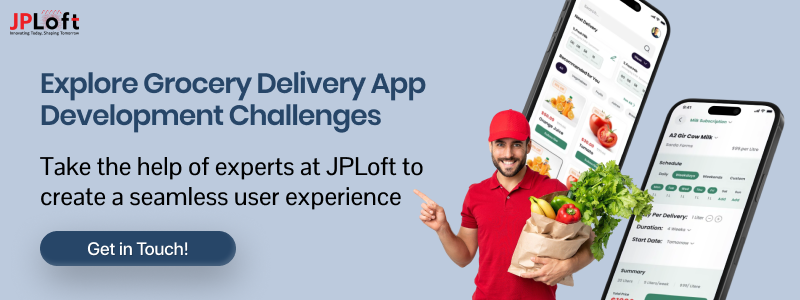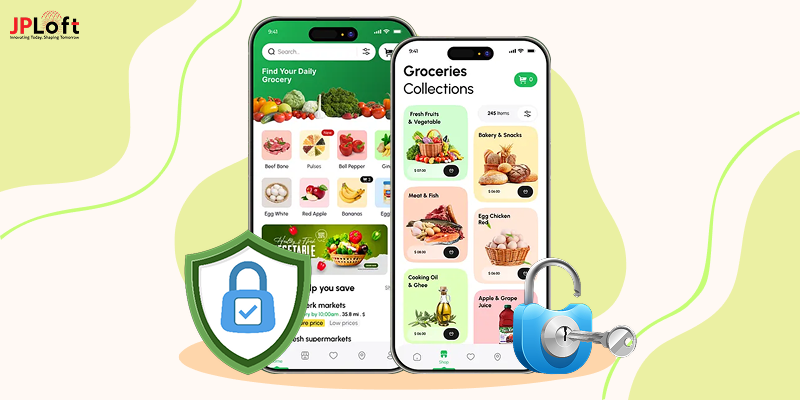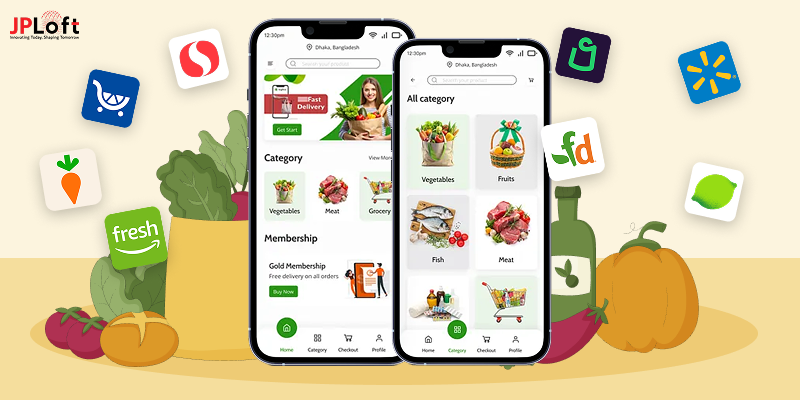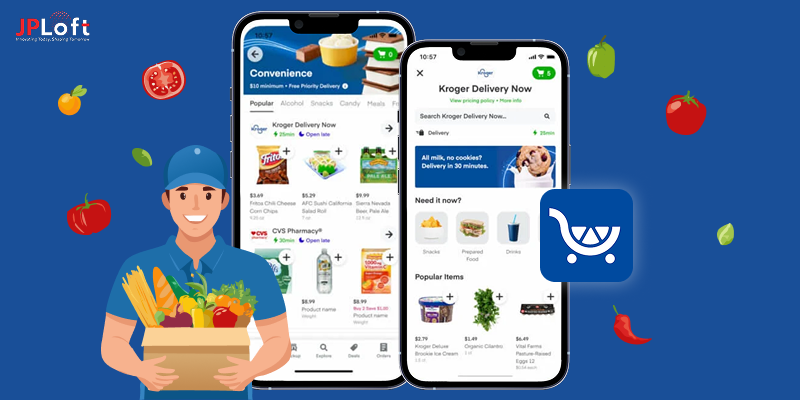Building a grocery delivery app might sound straightforward, but it comes with a whole set of challenges that go way beyond just creating a functional app.
Developers have to juggle a lot, like keeping inventory updated in real-time, making sure the user experience is smooth, handling secure payment, and coordinating deliveries efficiently.
On top of that, the competition is fierce, and users expect fast, reliable service with no hiccups, whether it’s timely deliveries, easy navigation, or instant customer support.
Today’s consumers are used to smooth, on-demand experiences, so even the smallest delay or glitch can lead to frustration and app abandonment.
In this discussion, we’ll explore the main challenges developers face and what it takes to create a grocery delivery app that’s functional, user-friendly, secure, and ready to compete in a crowded market.
What is a Grocery Delivery App?
Grocery delivery apps have transformed the way people shop for groceries, reshaping consumer habits and making daily errands more convenient.
These platforms connect users with local supermarkets and grocery stores, offering a wide range of products including fresh fruits, vegetables, dairy items, and more.
Users are provided with a variety of features, including product customization, the ability to add items to their cart, secure payment options, and real-time order tracking, all accessible from the convenience of their smartphones or tablets.
With their growing popularity, these apps are becoming an essential part of modern, on-the-go lifestyles.
Moving forward on a global scale, grocery delivery apps have demonstrated significant growth, generating substantial profits for many investors who have recognized their rising potential in the market.
Grocery Delivery App Statistics
Grocery delivery apps have gained so much popularity. Here are stats backing the statement:
-
- Globally, the United States is projected to lead the grocery delivery market, generating an estimated revenue of US$327.72 billion in 2025.
- By 2030, the number of users in the grocery delivery market is expected to reach approximately 2.3 billion.
- The market is forecasted to grow at a compound annual growth rate (CAGR) of 9.74% from 2025 to 2030, with revenue projected to hit US$1.49 trillion by the end of the period.
- In 2025, the average revenue per user (ARPU) is anticipated to reach US$546.12.
As these industries have risen many times, they have also faced numerous challenges.
Below, we have given grocery delivery app development challenges, highlighting the complexity of building a reliable, user-friendly, and efficient platform in a competitive market.
10 Key Challenges While Developing a Grocery Delivery App
Developers encounter various challenges when building modern delivery platforms.
In this section, we’ll guide you through how to create a grocery delivery app while effectively overcoming these obstacles.
1. Real-time Inventory Management
One of the toughest challenges in grocery delivery apps is maintaining accurate stock levels and product availability instantly, especially when inventory fluctuates rapidly across multiple suppliers, stores, and warehouses.
Among the key challenges in grocery delivery app development, managing real-time inventory efficiently is critical to ensuring customer satisfaction and operational success.
This requires seamless integration with various inventory management systems and real-time data synchronization to prevent issues like overselling, stockouts, or delayed updates.
Ensuring this level of accuracy is critical to providing a reliable user experience and maintaining customer trust in the platform.
Solution:
To tackle these grocery app challenges, developers can implement robust API integrations with suppliers’ inventory systems to enable instant updates.
Utilizing cloud-based platforms and automated synchronization tools ensures data is continuously refreshed across all channels.
Additionally, incorporating predictive analytics can help anticipate stock shortages and manage demand more effectively.
Regular audits and alerts for discrepancies further enhance accuracy, ensuring a smooth, reliable shopping experience for users.
2. Order Processing and Optimization
Handling high volumes of orders while maintaining speed and efficiency is a significant challenge.
As user demand spikes, especially during peak hours or holidays, the system must process multiple orders simultaneously without delays or errors.
Efficient order batching, route planning, and coordination with delivery partners become crucial.
Any lag in order processing can lead to customer dissatisfaction.
While facing challenges in building a grocery delivery app, addressing these issues early on can lead to more effective solutions and smoother development.
Solution:
To overcome this challenge, it's essential to implement advanced order management systems that can automate and streamline the entire process.
Features like real-time order tracking, smart order batching, and AI-powered route optimization help improve efficiency and reduce delivery times.
When you create an app with these capabilities, it not only enhances performance during peak periods but also ensures a smooth and satisfying experience for both customers and delivery personnel.
3. Logistics and Delivery Coordination
Coordinating timely deliveries while managing a fleet of drivers, traffic conditions, and multiple delivery locations is a complex task.
These operational complexities make logistics one of the toughest challenges in creating grocery app solutions that are both scalable and reliable.
These operational tasks make logistics one of the toughest challenges in creating real-time tracking and ensuring seamless communication between the app, warehouse, and delivery personnel.
Since these operations run around the clock, it's crucial for warehouses and delivery partners to stay constantly connected to ensure timely and accurate deliveries.
4. User Interface and Experience
Designing a clean, intuitive, and responsive user interface is a major challenge while creating a grocery delivery app.
Users expect a seamless experience from easy navigation and quick search functionality to smooth checkout and real-time updates.
Any complexity or lag in the interface can frustrate users and lead to app abandonment.
Striking the right balance between functionality and simplicity while catering to a diverse user base is essential but challenging.
Solution:
To overcome the challenges in grocery delivery app development.
Conduct usability testing to gain deeper insights into customer behavior and preferences.
Incorporate features like smart search, personalized recommendations, and a streamlined checkout process to enhance the overall user experience.
When you prioritize a smooth, intuitive, and engaging interface, you not only retain users but also boost satisfaction and long-term loyalty.
A well-designed experience can also set your grocery delivery app apart in a highly competitive market.
5. Payment Gateway Integration
Payment gateway integration is crucial for enabling secure, seamless transactions within grocery delivery apps.
Providing fast payments and multiple options, such as cash on delivery and various online methods, not only enhances user experience but also builds trust.
To tackle common challenges like payment security, transaction delays, and regulatory compliance, it's wise to hire dedicated developer expertise to ensure robust and compliant integration.
Solution:
To solve these problems, choose a trusted and PCI-DSS-compliant payment gateway provider.
Ensure the integration supports multiple payment options and currencies (if needed), and implement features like one-click payments and secure encryption.
Regular testing and monitoring of the payment system can help you to solve these grocery app challenges by identifying and resolving these issues quickly, helping to create a smooth and secure checkout experience for users.
A well-integrated and reliable payment system also builds user confidence, encouraging repeat purchases and long-term loyalty.
6. Data Privacy and Security
Safeguarding user information is a critical concern during app development.
It is a top challenge in grocery app development that involves significant risks, with one of the most critical being the threat of cyberattacks and the need for robust security measures.
These apps handle sensitive information such as personal details, delivery addresses, and payment credentials.
Any breach or mishandling of this data can result in serious legal consequences and a significant loss of user trust.
Solution:
Implement strong encryption protocols, secure authentication methods (like OTP or biometric login), and conduct regular security audits to safeguard user data.
Ensure compliance with data protection regulations such as GDPR or CCPA, depending on your market.
Educate users on security best practices and maintain transparency through clear privacy policies to build trust and credibility.
Additionally, limit data access based on user roles to minimize internal threats and enhance overall security.
Addressing these security concerns is one of the key challenges in grocery delivery app development that developers must prioritize.
7. Real-Time Tracking
Implementing accurate real-time tracking is a significant problem that all developers face while developing this feature.
To overcome this issue, you can seek help from the best mobile app development company.
After all, providing accurate real-time updates requires seamless integration of GPS technology, mapping services, and synchronized location data between the app and delivery personnel, all without delays or errors.
Inconsistent tracking can cause confusion, missed deliveries, and a poor user experience.
Solution:
To address this, integrate a reliable GPS and mapping API such as Google Maps or Mapbox, and ensure seamless coordination between the app, backend systems, and delivery drivers.
Use geofencing and real-time location sharing to improve accuracy.
Regularly test tracking features under various network conditions to ensure consistent performance and enhance customer confidence in the delivery process.
A dependable tracking system not only boosts transparency but also reduces the number of customer support queries related to order status.
8. Scalability
Scalability is a major problem that is faced, especially when demand is high.
An app that performs well with a few hundred users might crash or slow down under the load of thousands.
Handling these grocery delivery app development challenges, like managing large volumes of orders, updating real-time data processing, and simultaneous user interactions, requires a robust and scalable infrastructure.
Without proper scalability, performance issues can lead to user dissatisfaction and lost business opportunities.
To stay competitive, the app must be built to scale seamlessly as both the user base and vendor network expand.
Solution:
To ensure scalability, build the app on a cloud-based infrastructure that can dynamically scale resources as needed.
Use micro services architecture to break down functionalities for easier scaling and maintenance.
Implement load balancing, database optimization, and caching mechanisms to manage high traffic smoothly.
Regular stress testing can help identify and address potential bottlenecks before they affect real users.
9. Multi-Vendor Support
Multi-vendor support requires managing diverse inventories, pricing, and logistics while ensuring a seamless user experience and efficient backend operations.
The common challenges in creating a grocery app are faced while operating a unique product catalogue, pricing structures, inventory systems, and delivery zones.
Coordinating orders across these device sellers while maintaining a smooth and unified user experience adds significant complexity.
Furthermore, handling vendor-specific promotions, commission models, and rating systems demands a highly adaptable and well-structured backend infrastructure.
Solution:
These soluble challenges in creating a grocery app require a lot of vendor management, inventory check, and order dependability.
Leveraging standardized APIs enables smooth integration of vendor systems and facilitates efficient inter-system communication.
Maintaining transparency between vendors and customers is crucial for building credibility.
Implementing features such as vendor ratings and review systems fosters trust and empowers users to make well-informed decisions.
Altogether, this organized approach streamlines operations and delivers a unified user experience, even when multiple vendors are involved.
10. Customer Support and Feedback Management
Providing effective communication support is essential for addressing customer concerns promptly and professionally.
Unresolved issues, whether related to orders, payments, or deliveries, can escalate and impact user satisfaction and app ratings.
Since these are common challenges when building a grocery app, creating a reliable support system is crucial.
Additionally, managing feedback through an organized process improves the user experience.
When considering the cost to create an app, investing in strong customer support features should be a top priority.
Solution:
Integrate multiple support channels, like in-app chat, email, and phone support, to offer quick assistance.
Use AI-powered chatbots for instant responses to common queries and route complex issues to human agents.
Implement a user-friendly feedback system that encourages customers to share their experiences.
Regularly analyze feedback data to identify areas for improvement, ensuring continuous enhancement of both the app and customer service.
How JPLoft Can Help You Build a Successful Grocery Delivery App?
JPLoft can be your ideal partner in bringing a powerful grocery delivery app to life.
From concept to deployment, we offer complete design and development services tailored to your business needs.
Our team focuses on creating feature-rich, scalable, and user-friendly apps that handle everything from real-time order tracking to multi-vendor management.
With deep industry knowledge and a focus on performance, we ensure your app stands out in a competitive market.
Whether you're targeting a local audience or aiming for large-scale operations, JPLoft provides the technical expertise and support needed at every stage.
As a trusted grocery delivery app development company, we help you overcome common challenges and launch an app that delivers convenience, speed, and reliability to your customers.
Let us turn your idea into a successful digital solution.
Conclusion
Building a grocery delivery app sounds exciting, but it definitely comes with its fair share of challenges.
You’ve got to juggle vendor management, real-time inventory tracking, secure payments, and making sure deliveries happen on time.
Sounds like a lot, right?
That’s why using standardized APIs is so important; it keeps everything connected and running smoothly.
On top of that, adding features like vendor ratings and reviews helps build trust with users, which is a big deal.
And let’s not forget customer support people want quick help when something goes wrong.
If you don’t tackle these challenges early on, they can become bigger headaches down the road.
But with the right planning and a focus on user experience, you can build a grocery app that’s not just functional but one people actually love using.
FAQs
Scalability can be addressed by using cloud-based infrastructure, optimizing code and database queries, and planning for peak traffic from the start.
This requires syncing the app with vendor inventory systems or providing vendor dashboards to manually update stock in real time.
Balancing a clean interface with multiple features, simplifying the checkout process, and minimizing user friction are key design challenges.
Coordinating deliveries across multiple zones, managing delivery personnel, and optimizing routes in real time require smart algorithms and location-based services.
Ensuring secure, fast, and seamless transactions while supporting multiple payment gateways and refund processes can be complex.













Share this blog